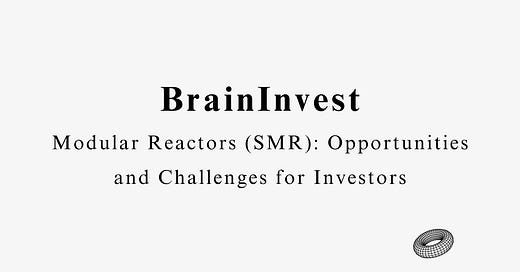Modular Reactors (SMR): Opportunities and Challenges for Investors
A big thank you to all those who subscribed. Feel free to share this newsletter with your link to enjoy the gifts !!! 😉
Hi everyone,
My name is Jean-Baptiste Vaujour, I am an energy economist, consultant and Professor of Practice at EMLyon Business School. I want to thank Arthur for having me on his newsletter and for keeping us up to date on the start-up & investment debate. I am here to follow-up with Arthur on his article on SMR / AMR (Small and Advanced Modular Reactors) that generated a lot of interest in social media.
The big news, as you may have seen is that Google (!) decided to sign Power Purchasing Agreement (PPAs) with Kairos Power to help the company deliver its first AMRs by 2030-35. Google is contractually committing to purchase the electricity which means it becomes a lot easier for Kairos to raise debt financing to build the reactors. This follows Microsoft’s decision to sign a contract with Constellation last month in order to restart a traditional nuclear power plant. This is probably the beginning of a trend as tech giants are increasingly looking for power sources that are both decarbonised and available 24/7, without intermittency, to power the massive computing requirements behind the development of AI models.
SMR/AMR provide them with a series of advantage. They are “easier” – well, so to speak – and faster to build than traditional reactors, their production is stable over time (except during maintenance and core reloading operations) and they can be deployed (nearly) anywhere as they do not require massive transmission network upgrades.
So what does an investor need to know about this, beyond the hype:
ASMRs are still nuclear reactors, it is never going to be easy to build and delays are to be expected, especially for lead reactors that will have to clear all the technical, regulatory and economic hurdles;
ASMRs require a lot of stakeholders to build and operate, it’s not just Kairo or EDF Nuward (in France) that are responsible for the project. A lot of contractors both big and small, sometimes highly specialised, are going to be involved at project level and these companies are interesting and often overlooked investment opportunities;
Getting the permits, the design, the funds and the contractors to build a nuclear reactor that actually works as intended is a complex endeavour by itself, ASMR will have issues on all these dimensions for their first reactors but the whole economic point of these reactors is to benefit from a learning curve and drastically reduce their cost and construction time;
The first big issue that is currently overlooked is that operating and maintaining an ASMR might be easier than a traditional reactor but it is by no means easy. The safety concerns and quality requirements are similar and require the permanent vigilance of a well-trained staff;
The second big issue concerns nuclear waste and end-of-life management of the power plant. These topics are covered for traditional reactors but remain yet highly theoretical for ASMRs and will require clarification as they may significantly reduce profitability (i.e. nuclear power plant operators need to set resources aside to cover for waste and decommissioning).
Thanks a lot,
, for your sharp analysis. I’d like to add a few thoughts to complement my previous article.First problem for investors: market size
It's awesome to see the big tech players like the GAFAMs getting into SMRs, but who else really needs SMRs in developed countries? Sure, big industries like foundries or gas production could be interested, but the market is just too small for more than one player per geographical area.
So, why not export?
The second big issue is all about the choice of fuel. There are two main options: using of high-density uranioma like the main SMRs from CEA (France) or Thorium (low density) like Copenhagen Atomics. What may seem like a minor technical detail is actually a game-changer. Exporting nuclear technologies in the current geopolitical context is a risk few governments will take. Yet, the 600 million people who need this technology are in Turkey, Central Africa, South Africa, Madagascar, Lebanon, on independent islands… The real market isn’t in developed countries, which already have plenty of energy sources (somewhat green or not). So, the goal is to find solutions that are efficient enough without posing a significant military risk.
This point alone knocks out over 50% of the projects that have been launched in recent years.
The production question
My last big hang-up is around production. After diving deep into about ten startups in this ecosystem, I’ve noticed they’re all set up with a research and lab mindset, not industrialization. It’s a point I recently discussed with Marc Simoncini: being an entrepreneur means cutting out all the non-essential stuff, while being a researcher is about chasing perfection. And those two approaches just don’t fit with industrial-scale production.
To wrap it up, I’m still super excited about this sector
But it’s been massively propped up by public policies and subsidies with no real economic foundation. We need to think about market size, product industrialization, and the potential for export. To change the world, you’ve got to stay grounded in it.
And what about funding?
I’m not diving into this in detail right now, but here’s the deal: think factory, not startup. Aiming for a 100x return in 7 years seems pretty ambitious in this space. Yet, the IRR can be huge over a 20-year horizon – it just needs to be factored into the financing strategy. Which raises the question: is this really compatible with traditional VCs?
Thanks a bunch for reading this far! Feel free to share this edition (and the previous ones) and enjoy lots of perks: stickers, caps, access to events…
Previous articles you'll love :
Catch you soon!





